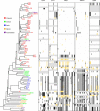Evidence for domesticated and wild populations of Saccharomyces cerevisiae
- PMID: 16103919
- PMCID: PMC1183524
- DOI: 10.1371/journal.pgen.0010005
Evidence for domesticated and wild populations of Saccharomyces cerevisiae
Abstract
Saccharomyces cerevisiae is predominantly found in association with human activities, particularly the production of alcoholic beverages. S. paradoxus, the closest known relative of S. cerevisiae, is commonly found on exudates and bark of deciduous trees and in associated soils. This has lead to the idea that S. cerevisiae is a domesticated species, specialized for the fermentation of alcoholic beverages, and isolates of S. cerevisiae from other sources simply represent migrants from these fermentations. We have surveyed DNA sequence diversity at five loci in 81 strains of S. cerevisiae that were isolated from a variety of human and natural fermentations as well as sources unrelated to alcoholic beverage production, such as tree exudates and immunocompromised patients. Diversity within vineyard strains and within saké strains is low, consistent with their status as domesticated stocks. The oldest lineages and the majority of variation are found in strains from sources unrelated to wine production. We propose a model whereby two specialized breeds of S. cerevisiae have been created, one for the production of grape wine and one for the production of saké wine. We estimate that these two breeds have remained isolated from one another for thousands of years, consistent with the earliest archeological evidence for wine-making. We conclude that although there are clearly strains of S. cerevisiae specialized for the production of alcoholic beverages, these have been derived from natural populations unassociated with alcoholic beverage production, rather than the opposite.
Conflict of interest statement
Competing interests. The authors have declared that no competing interests exist.
Figures

References
-
- Sipiczk M, Romano P, Lipani G, Miklos I, Antunovics Z. Analysis of yeasts derived from natural fermentation in a Tokaj winery. Antonie Van Leeuwenhoek. 2001;79:97–105. - PubMed
-
- Mortimer RK. Evolution and variation of the yeast (Saccharomyces) genome. Genome Res. 2000;10:403–409. - PubMed
-
- Nguyen HV, Gaillardin C. Evolutionary relationships between the former species Saccharomyces uvarum and the hybrids Saccharomyces bayanus and Saccharomyces pastorianus; reinstatement of Saccharomyces uvarum (Beijerinck) as a distinct species. FEMS Yeast Res. 2005;5:471–483. - PubMed
-
- Pasteur L. Études sur le vin. Paris (France): Imprimeurs Imperials; 1866. 266. p.
LinkOut - more resources
Full Text Sources
Other Literature Sources
Molecular Biology Databases

